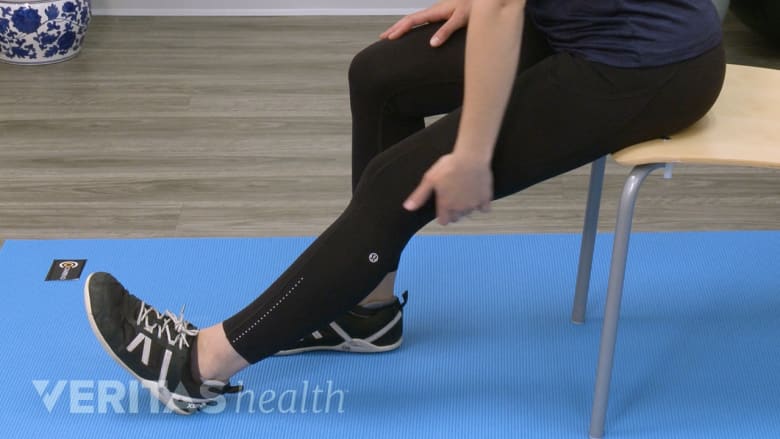Chiropractors may utilize various therapies for treating sacroiliac (SI) joint pain with the goals of reducing the patient's pain, improving function, and providing rehabilitation so the pain is less likely to return.
Pain is caused by either too much or too little movement of the sacroiliac joint.
As a result, muscles surrounding the joint may benefit from chiropractic techniques to either relax the muscles or to strengthen them.
In This Article:
- Chiropractic Procedures for the Sacroiliac Joint
- Gentle Chiropractic Techniques for the Sacroiliac Joint
- Adjunctive Therapy for Sacroiliac Joint Pain
- Chiropractic Adjustment of the Sacroiliac Joint Video
Muscle Relaxation Techniques

Hamstring stretches promote flexibility and reduce muscle tightness in the lower back and legs.
Muscle relaxation (muscle release) techniques are often applied during gentle chiropractic treatments to minimize excessive strain on the sacroiliac joint arising from an overly tight muscle.
Chiropractors may provide instruction for stretching certain muscles for SI joint problems, such as:
- Hamstrings - the muscles that run through the back of the thigh need specific hamstring stretches so they don’t become overly tight.
- Piriformis - the piriformis muscle may need to be stretched. This is the pear-shaped muscle that runs from the back of the upper thigh bone (femur) to the sacrum).
- Adductors - the four muscles from the pelvis to either the thigh bone or the knee that ultimately pull the legs together need stretching.
- TFL - this muscle is the tensor fascia lata muscle of the thigh, located on the outer aspect of the thigh.
- Overly tight, low back paraspinal muscles - the low back muscles typically need stretching.
Other treatments for tight muscles, such as hot packs and massage, may also be employed by the chiropractor.
- Hot packs may be used to warm up/relax tight muscles prior to the chiropractic adjustment and/or for use at home.
- Therapeutic massage is a direct way to relax overly tight muscles. In addition, massage therapy increases blood flow to the area, which in turn promotes healing.
Muscle Strengthening Techniques

Core strengthening exercises aim to strengthen core muscles and alleviate pain.
Strengthening the body's core muscles is important for stabilizing the sacroiliac joint.
While some of the body's core muscles are exercised in everyday life, working most of the stomach/back muscles is more difficult and requires a conscious approach to targeting them for strengthening.
Specific home-based exercises designed to strengthen the phasic (weak) muscles are often prescribed treatments in chiropractic, for example:
- Abdominal muscles: pelvic tilt, trunk curl, exercise ball sit ups, sit backs, abdominal bracing
- Back muscles: kneeling or prone arm/leg raises, cat curls, exercise ball or floor extensions
An exercise ball is an excellent tool for strengthening core body muscles. The body responds to the instability of the ball to remain balanced, engaging many more muscles and neuropathways than when the body is exercised on a stable surface.
Additional Support for the Sacroiliac Joint
When lower back pain arising from the sacroiliac joint is not responding to treatment, additional support and/or treatment may be necessary, such as:
- Sacroiliac belt/support: An elasticized belt tightened around the waist using Velcro can help support the sacroiliac joint
- Shoe insert: An anatomical short leg may require a heel lift, arch support or a combination of both
- TENS: A Transcutaneous Electrical Nerve Stimulators (TENS) device produces electrical stimulation using electrodes for pain treatment. It is believed that the electrical current directly blocks the transmission of pain signals along nerves
- Ice packs and rest: Ice packs are applied as needed to reduce inflammation in the area, along with short periods of rest to reduce irritation
- Physiological therapeutic modalities: Electrical stimulation, pulsed magnetic field, low level laser or class IV laser - may facilitate recovery by reducing inflammation and hence, pain
- Weight loss management and diet: This approach is appropriate for treating sacroiliac joint dysfunction as is true for any chronic lower back condition. An anti-inflammatory diet, such as a gluten-free diet, is a good option for weight reduction in addition to other general health benefits of reducing the inflammatory markers in the body.
In addition, the treating chiropractor typically discusses common triggers for SI joint pain and provides advice on how to avoid them.
The chiropractor will perform a thorough evaluation, including a physical examination and medical history, to diagnose si joint dysfunction and to determine if there are any coexisting conditions that require treatment in addition to sacroiliac joint dysfunction. A whole-body approach is optimal when developing a treatment plan for each patient.

